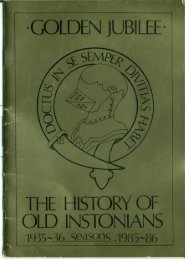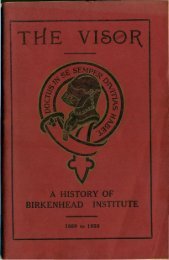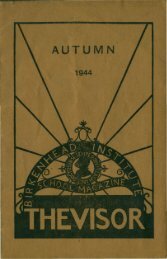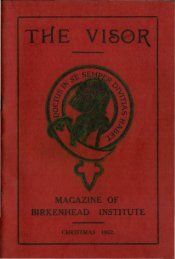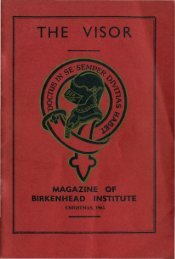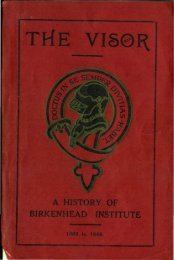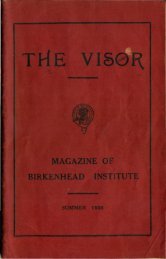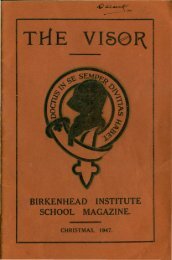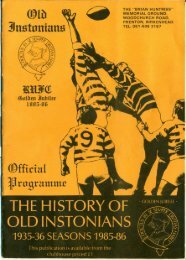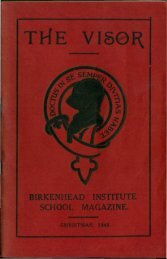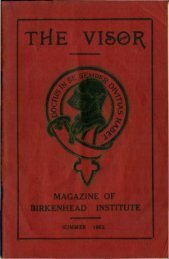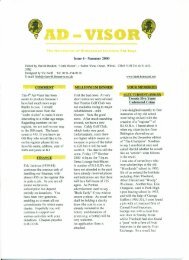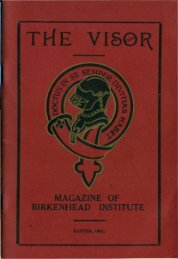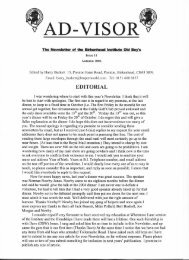1963 - Easter - Birkenhead Institute Old Boys
1963 - Easter - Birkenhead Institute Old Boys
1963 - Easter - Birkenhead Institute Old Boys
Create successful ePaper yourself
Turn your PDF publications into a flip-book with our unique Google optimized e-Paper software.
But how did it happen? There must have been energy of some kind,thought Dr. Miller. Perhaps the energy came from lightning! So Dr.Miller got to work. He mixed together ammonia, methane and watervapour in a large glass bottle. He sealed into the glass walls of the bottletwo metal wires. He connected the wires to a source of high voltageelectricity so that a spark passed through the mixture of gases. For awhole week Dr. Miller kept sparks passing through the bottle. At theend of the week he noticed some drops of strange liquid on the walls ofthe bottle. He hastily analysed them and to his surprise found traces ofchemicals called amino acids. There are the chemicals which go to makeproteins, which are part of all living cells.Dr. Miller tried his experiment again and again. He used differentsizes of bottles, he used different proportions of gases in the mixture. Helet the sparks pass for different lengths of time. Yet in spite of all thechanges he made, he always ended up with samples of amino acids. Todayscientists have analysed most of the important proteins occurring in livingcells. They have found they contain just the amino acids that Dr. Miller'sexperiment produced.A. J. ELLIOlT, 4A.BIRD-WATCHING AS A HOBBY.THERE are not many sports or hobbies which combine an interestingpastime with a healthy outdoor life; bird-watching is one of few.As man makes progress, so the birds go rarer and rarer until extinct.The Red or Welsh Kite for example, which was once common all overthe British Isles, is now on the verge of extinction and is confined to afew hill districts of Central Wales. It was persecuted by farmers and itsnests robbed by egg-collectors until there were only about three pairsleft. The Royal Society for the Protection of Birds (R.S.P.B.) and otherornithological societies then started to protect it. Myxomatosis thenspread among the rabbits, the Welsh Kite's chief food; this reduced theirnumbers greatly. Then came the bad winter of 1947; Carrion Crows andhigh winds all took their toll, and today there are still only twelve pairsof Welsh Kites left.Until recently, all hawks except the Sparrowhawk were protected;now every hawk is protected, but still game keepers shoot every hawkthey see including the comparatively harmless Kestrel.Falcons were always shot in the war for fear of their killing CarrierPigeons with valuable messages, now falcons are used on airstrips toclear the runways of birds which could cause a plane to crash by beingsucked into the propellors; this happened with starlings on an Americanairliner and about sixty three lives were lost.Recently six birds were crossed off the official British Bird list; theseare known as the "Hastings Rarities".This winter has been as bad as that of 1947 in some places, but inCheshire it has not been too bad, with the result that winter migrantsfrom Scandinavia, the Redwing and Fieldfare, have been abundant inthe North West of Cheshire and in fact over most of Cheshire. The firstRedwing that I saw was in Clatterbridge by a stream near the hospital.I would have passed it off as a Song Thrush but for the creamy whiteeyes tripes above and below the eyes. The Fieldfares that I have seen havebeen concentrated around the Storeton area; these birds look like MistleThrushes with grey heads and rumps.



